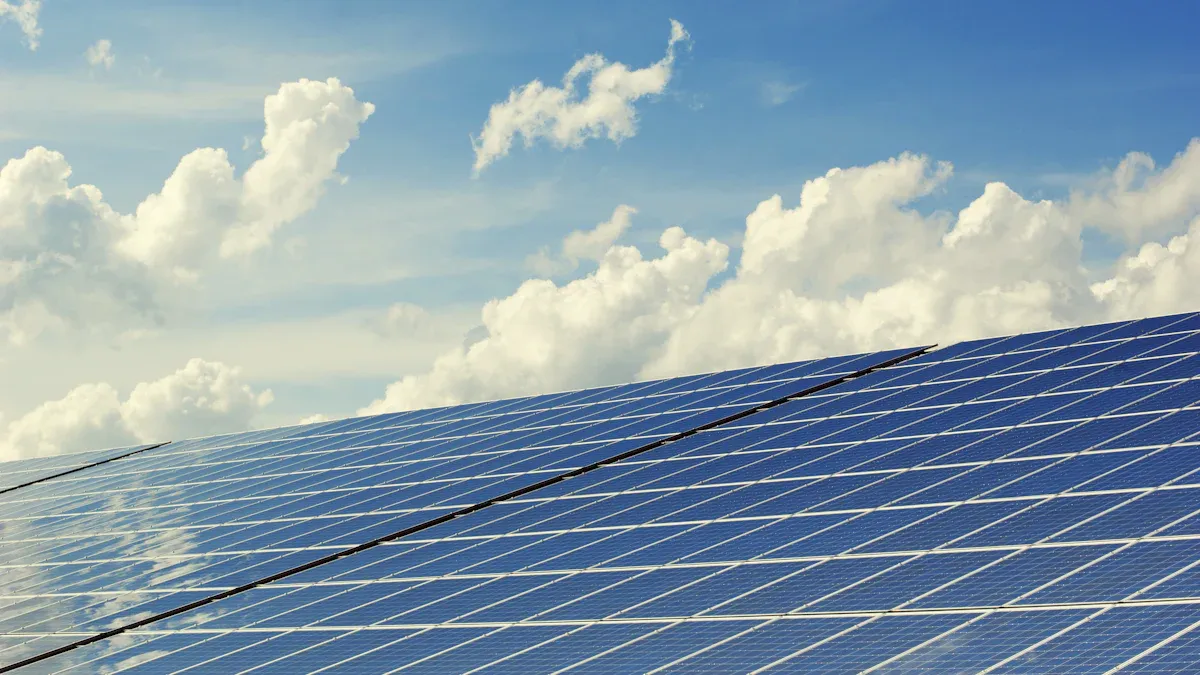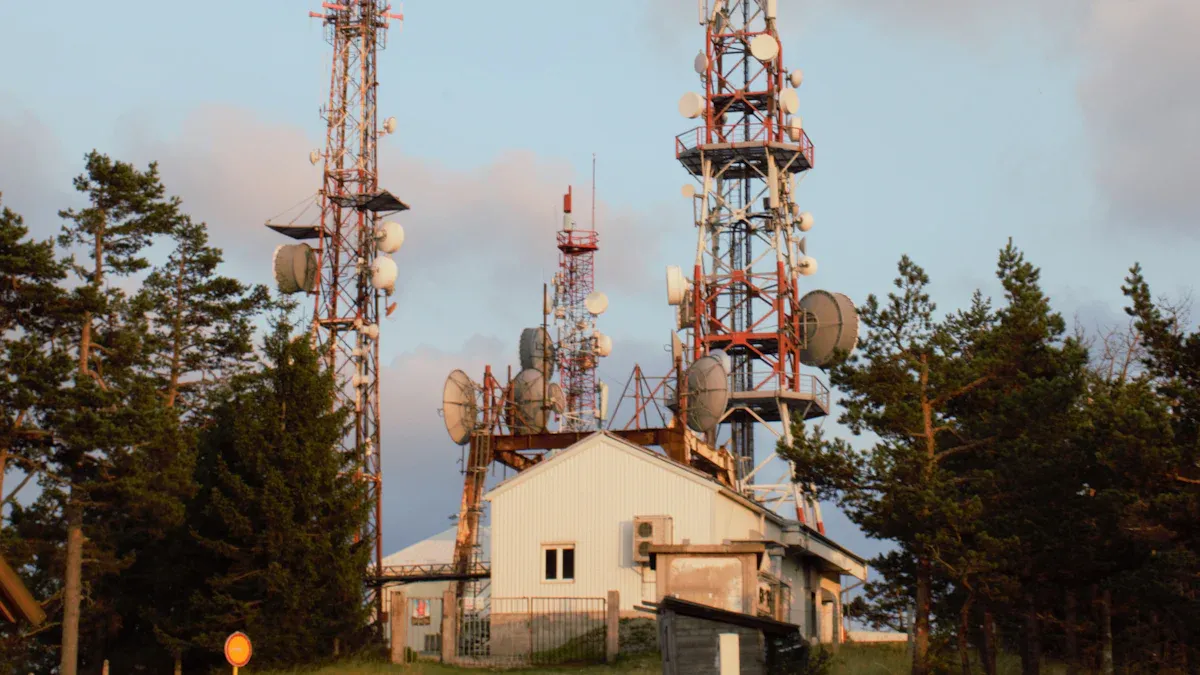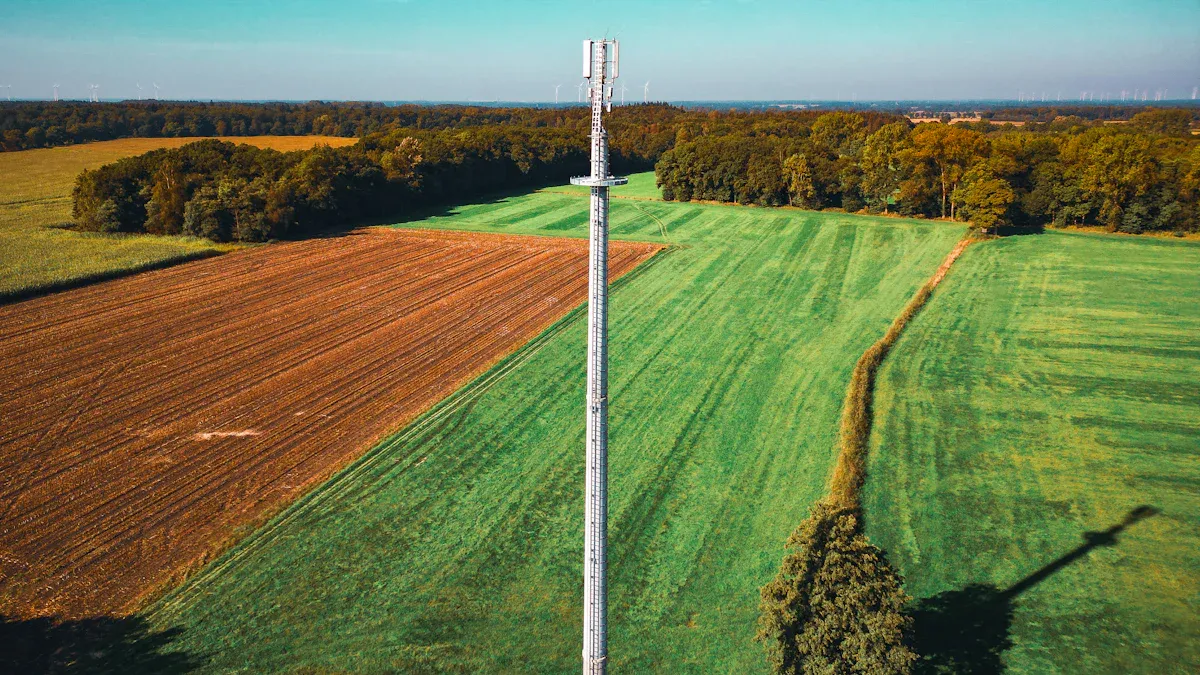Energy-Efficient Telecom Power Systems for a Sustainable Future

You help create a better future by using energy-saving telecom systems. These systems lower pollution and save money on running costs. For example:
Telecom power systems improve energy use in many industries.
New technology makes energy use better and more sustainable.
Also, energy-saving tools like PBX systems cut electricity costs and use power wisely. By choosing smart power solutions, you support a cleaner Earth and keep telecom services reliable. These systems are key to making telecom work cheaper and eco-friendly.
Key Takeaways
Energy-saving telecom systems cut costs and lower pollution. They are a great option for a greener future.
Using lithium-ion batteries instead of VRLA batteries lasts longer, charges faster, and stores energy better for telecom use.
Adding solar or wind energy to telecom systems makes them more reliable and helps the environment.
Hybrid power systems mix renewable energy with backups to keep power steady, even in tough situations.
Smart energy tools like AI and IoT help save energy and make systems work better.
Current Telecom Power System Technologies
VRLA Batteries: Affordable and Reliable
Valve-Regulated Lead-Acid (VRLA) batteries are a common pick for telecom systems. They are cheap and dependable, making them great for backup power. These batteries are especially useful in areas where low-cost solutions are needed. Their sealed design means less upkeep, which is helpful for reliable power setups.
Tip: Choose VRLA batteries if you need low-cost and simple maintenance.
Still, VRLA batteries have some downsides. They don’t last as long as newer batteries and store less energy. Even so, they are widely used because they are trustworthy and cost-effective.
Metric | Value |
|---|---|
Growth Rate | Over X% |
Units by 2033 | Hundreds of millions |
Key Reason | Rising need for backup power in growing economies |
Extra Factor | More use in telecom systems |
Lithium-Ion Batteries: The Modern Choice
Lithium-ion batteries are changing telecom power systems with their top-notch features. They last longer, charge faster, and store more energy than VRLA batteries. These batteries are lighter and come with built-in monitoring, making them perfect for today’s telecom setups.
Feature | Lithium-Ion Batteries | VRLA Batteries |
|---|---|---|
Energy Storage | Higher | Lower |
Weight | Lighter | Heavier |
Lifespan | Longer | Shorter |
Charging Speed | Faster | Slower |
Built-In Monitoring | Yes | No |
Ownership Cost | Lower | Higher |
Lithium-ion batteries are great for jobs needing steady power and little downtime. They can handle many charge cycles, making them a smart and eco-friendly choice.
Note: Lithium-ion batteries are also used in electric cars, solar panels, and boats because they are strong and efficient.
Battery Type | Lifespan (Years) | Energy Stored (Wh/kg) | Charge Cycles |
|---|---|---|---|
Lithium | 8-10 | 110-250 | 3,000-5,000 |
Lead-Acid | 2-3 | 30-50 | 500-1,000 |
Nickel-Based | 3-5 | 60-120 | 1,000-1,500 |
Nickel-Cadmium Batteries: Tough but Harmful
Nickel-Cadmium (NiCd) batteries are strong and reliable, making them useful for telecom systems. They work well in extreme weather and keep power steady, ensuring telecom systems run smoothly.
But, NiCd batteries can harm the environment. Cadmium is toxic, and throwing these batteries away carelessly can damage nature. This is something to think about when picking NiCd batteries.
Alert: While NiCd batteries are tough, their environmental harm makes them less ideal than lithium-ion batteries.
Their lifespan and energy storage are average, but they handle tough conditions well. As greener options grow, NiCd batteries may be used less in favor of eco-friendly choices.
Fuel Cells: A Sustainable Telecom Power Alternative
Fuel cells are a smart way to power telecom systems. They make electricity by mixing hydrogen and oxygen, creating only water as waste. These cells give clean, steady, and efficient energy for telecom use.
Why Fuel Cells Are Special
Fuel cells have benefits that make them great for telecom power:
Eco-Friendly Operation: Fuel cells don’t release harmful gases. Using them helps lower your carbon footprint.
High Efficiency: They turn chemical energy into electricity with little waste. This means more energy from every bit of fuel.
Quiet Performance: Fuel cells work silently, making them good for homes and cities.
Tip: Choose fuel cells if you want clean and efficient energy.
How Telecom Uses Fuel Cells
Fuel cells can help in many telecom situations:
Backup Power: They keep telecom running during power outages.
Remote Locations: Fuel cells power towers where there’s no electricity grid.
Hybrid Systems: Combine fuel cells with solar panels for better reliability.
Challenges to Think About
Fuel cells have some problems you should know:
Challenge | Impact | Solution |
|---|---|---|
High Initial Cost | They cost a lot to set up. | Savings over time make up for it. |
Hydrogen Storage | Storing hydrogen safely is tricky. | Better storage tech makes it safer. |
Limited Infrastructure | Few places to refuel hydrogen. | Building more stations is needed. |
Note: Even with these issues, fuel cells are worth it for their long-term benefits.
The Future of Fuel Cells in Telecom
Fuel cells are improving fast. New ways to make and store hydrogen are lowering costs. If you want sustainable telecom power, fuel cells are a smart choice. Using them helps create a cleaner and more reliable future.
Integration of Telecom Power Systems with Renewable Energy

Solar Energy: Using the Sun for Power
Solar energy is a clean and endless power source for telecom. It uses sunlight to make electricity, cutting down on fuel use. Solar panels turn sunlight into power, helping telecom systems run sustainably. This works best in sunny areas with lots of sunlight.
Many telecom companies already use solar energy to meet green goals. For example:
Company | Achievement/Statistic | Year |
|---|---|---|
Swisscom | 100% renewable energy supply | Since 2010 |
Vivo Brazil | 20% of electricity needs covered by renewable sources | N/A |
T-Mobile | 100% renewable energy usage for 5G network | 2022 |
Vodafone | 100% renewable energy for European operations | 2021 |
Telefónica | Saved 208 GWh and avoided 56,500 tons of CO₂ emissions | Over 3 years |
Solar-powered telecom systems save money on energy bills. Once installed, solar panels need little care and give free power for years. This makes them a smart and cost-saving choice for telecom networks.
Tip: Solar energy is great for eco-friendly and steady telecom power.
Wind Energy: Using Air to Create Power
Wind energy is another green option for telecom systems. Wind turbines make electricity by using the energy from moving air. This works well in windy places, giving a clean and steady power source.
The energy use of telecom base stations shows why renewables matter:
Base stations worldwide use about 4.5 GW of energy.
Over 50% of telecom power is used by wireless networks.
50%–80% of this power goes to amplifiers.
Diesel generators in off-grid areas use lots of fuel and pollute, showing the need for cleaner options.
Wind energy lowers the need for diesel, saving money and helping the planet. It also powers remote telecom towers, keeping them running even without a power grid.
Note: Wind energy works best in windy areas for clean telecom power.
Hybrid Power Systems: Mixing Sources for Better Power
Hybrid power systems mix different energy sources for strong telecom power. They combine renewables like solar and wind with diesel generators and batteries. This ensures power is always available, even when renewables can’t be used.
Hybrid systems have many benefits:
They use renewables first but rely on backups when needed.
They adjust to local conditions, using resources wisely.
Generators help in areas with bad electricity, making systems more reliable.
Hybrid systems are cost-effective and eco-friendly for telecom power. They work well in areas with mixed energy sources, improving efficiency and reliability.
Tip: Hybrid systems are perfect for places with changing energy needs.
Applications of Energy-Efficient Telecom Power Systems
5G Networks: Handling High Energy Needs Sustainably
5G networks need strong and reliable power systems. With more devices and users, energy-saving systems are vital for managing data traffic. Using HetNets, which mix big and small base stations, helps save energy in 5G setups. Smart planning ensures 5G designs meet energy needs and stay eco-friendly.
Batteries like lithium-ion are key for powering 5G networks. They charge quickly, last longer, and keep networks running smoothly. Adding solar or wind power to 5G systems makes them even greener and more efficient.
Tip: Combine advanced batteries with renewable energy to boost 5G reliability.
IoT Devices: Steady Power for a Connected World
IoT devices, like smart home gadgets and sensors, need steady power. Energy-saving systems help these devices work without interruptions. Long-lasting batteries with high energy storage are perfect for IoT, reducing the need for replacements.
Hybrid systems are also great for IoT. They mix renewable energy with backup batteries to ensure constant power. This setup is reliable and better for the environment.
Note: Reliable power keeps IoT devices connected and sharing data in real time.
Macro Cell Sites: Saving Energy in Big Operations
Macro cell sites are the main part of telecom networks in cities. They use a lot of energy, so saving power is important. Advanced systems use smart methods like user connection plans and sleep modes to cut energy use.
Strategy/Metric | What It Does |
|---|---|
User Connection Plans | Links users efficiently to save energy and improve signals. |
Sleep Modes | Lowers power use when activity is low. |
Energy Use Models | Tracks energy use for different power levels. |
These methods save energy while keeping networks strong. For example, sleep modes let sites use less power during quiet times. Using these ideas lowers costs and energy waste.
Tip: Use energy-saving methods at macro cell sites to cut carbon emissions.
Future Trends in Telecom Power Systems

Modular Telecom Power System Designs: Easy to Expand
Modular power systems are changing how telecom networks grow. These systems let you add or swap parts without stopping the whole system. This makes it simple to expand as your needs increase.
Main advantages include:
Scalability: Add services easily without breaking the system.
Reliability: Keeps systems stable and supports long-term green goals.
Efficiency: Adjust power to fit needs, cutting waste and downtime.
Feature | Benefit |
|---|---|
Modularity | Add or replace parts without big changes. |
Scalability | Grow services without breaking the system. |
Reliability | Keeps systems steady and eco-friendly. |
Modular systems make upgrades easy and avoid interruptions. They are perfect for new tech like 5G and IoT, where flexibility is key.
Advanced Battery Technology: Better Storage and Longer Life
New battery designs improve energy storage and last longer for telecom use. Lithium-ion batteries are the best, storing up to 250 Wh/kg and lasting 3,000 cycles. They work better than older batteries like VRLA and Nickel-Cadmium.
Battery Type | Energy Stored (Wh/kg) | Lifespan (cycles) |
|---|---|---|
Lithium-Ion | Up to 250 | Up to 3,000 |
VRLA | 20-40 | Less than 350 |
Nickel-Cadmium | 40-60 | Around 2,000 |
These batteries need fewer replacements and less care. They are great for remote areas where steady power is important. Using them saves energy and helps the planet.
Smart Energy Management: Using AI and IoT
AI and IoT are making telecom power smarter. They use live data to save energy and work better. AI predicts power needs and adjusts cooling, saving up to 30% energy.
Smart sensors check energy use and find problems early. This keeps systems running smoothly and sustainably.
Benefits of AI and IoT include:
Energy Savings: AI can cut energy use by 30%.
Better Resource Use: Sensors help manage power wisely.
Eco-Friendly: Lower energy use helps the environment.
With AI and IoT, telecom power systems become smarter and greener, ready for future needs.
Energy-saving telecom power systems can greatly change the industry. Using new technologies improves energy use and helps the planet. Experts from iTEAM Research Institute explain how these systems cut costs and boost sustainability. Also, IEEE Access studies show Demand Response systems save electricity, making them useful for industries.
Falling prices of solar and wind energy make this change easier. By focusing on energy-saving telecom setups, you help the Earth and ensure steady power. Start now to use these solutions and guide telecom toward a greener future.
FAQ
What are the benefits of energy-efficient telecom power systems?
Energy-saving systems cut electricity bills and help the environment. They make telecom services more reliable and meet green goals. Using these systems helps keep the planet clean and telecom running smoothly.
How do renewable energy sources integrate with telecom power systems?
Solar and wind energy give clean power to telecom setups. Hybrid systems mix renewables with batteries or generators for steady power. This setup lowers pollution and makes energy more dependable.
Are lithium-ion batteries better than VRLA batteries for telecom?
Yes, lithium-ion batteries last longer and store more energy. They charge quickly, weigh less, and need little care. These features make them better for today’s telecom needs than VRLA batteries.
Can fuel cells replace traditional power sources in telecom?
Fuel cells use hydrogen and oxygen to make clean energy. They are great for backup power and faraway places. Though costly at first, they are a smart and eco-friendly choice over time.
How does AI improve energy management in telecom systems?
AI predicts energy needs and uses power wisely. It cuts waste by managing cooling and other tasks. Smart sensors find problems early, keeping systems working well. This saves energy and helps the environment.
See Also
Essential Insights Into Telecom Power Supply Characteristics
Solar Energy Storage Solutions for Telecom Cabinet Systems
Strategies for Maintaining Reliable Power in Telecom Cabinets
Innovative Energy Storage Solutions for Telecom Cabinets
Integrated Solar Inverter and Battery Systems for Telecom Cabinets
CALL US DIRECTLY
86-13752765943
3A-8, SHUIWAN 1979 SQUARE (PHASE II), NO.111, TAIZI ROAD,SHUIWAN COMMUNITY, ZHAOSHANG STREET, NANSHAN DISTRICT, SHENZHEN, GUANGDONG, CHINA

